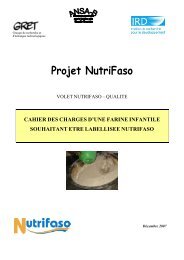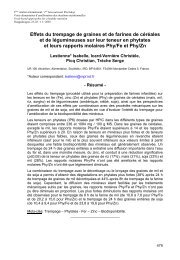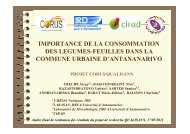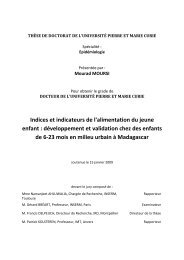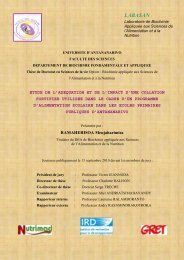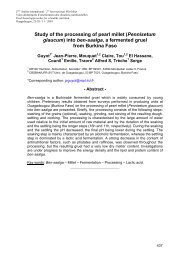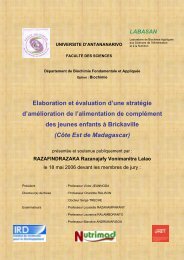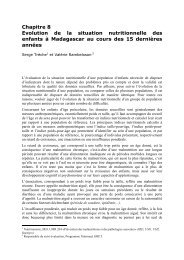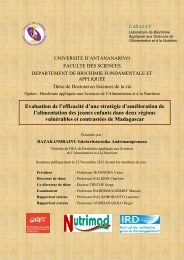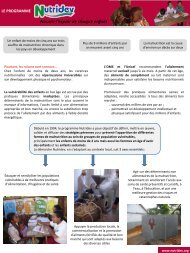THESE UNIQUE El Hassane Kéhien-Piho TOU - Nutridev
THESE UNIQUE El Hassane Kéhien-Piho TOU - Nutridev
THESE UNIQUE El Hassane Kéhien-Piho TOU - Nutridev
Create successful ePaper yourself
Turn your PDF publications into a flip-book with our unique Google optimized e-Paper software.
938 E.H. Tou et al. / Food Chemistry 100 (2007) 935–943<br />
amperometry and the eluant used was 90 mM sodium<br />
hydroxide solution. The results were expressed in mmol/l.<br />
2.7. Statistical analysis<br />
Data were submitted to analysis of variance (ANOVA).<br />
DuncanÕs multiple range tests was were used to separate<br />
means. Significance was accepted at the probability<br />
P 6 0.05 (Duncan, 1955).<br />
3. Results<br />
3.1. Effect of the different process combinations (CI, CM,<br />
CMI) on fermentation kinetics<br />
3.1.1. Changes in pH<br />
In all process combinations, pH decreased during the<br />
settling step to reach a value below 4.0 (Fig. 2). Except in<br />
the process combination including pre-cooking and the<br />
addition of malt (CM), acidification followed a similar<br />
and classical pattern (Fig. 2).<br />
The first phase of accelerated acidification occurred at<br />
the beginning of the fermentation step (from 0 to 6 h),<br />
and resulted in a pH decrease from an initial value<br />
around 6.0 to a final value around 4.0, followed by a<br />
phase of slow acidification (from 6 to 24 h), that resulted<br />
in a further decrease in pH to around 3.7. In the CM<br />
process combination, the pH was almost constant during<br />
the first 6 h of settling (5.73–5.53) and then decreased<br />
very slowly and continuously from 6 to 24 h to reach<br />
3.8. In this case, acidification was considerably delayed<br />
by the fact that the natural lactic microflora has been<br />
seriously affected by the pre-cooking stage. This justify<br />
the need of the post-cooking inoculation step. As shown<br />
pH<br />
7<br />
6<br />
5<br />
4<br />
CMI<br />
CM<br />
Control<br />
3<br />
0 4 8 12 16 20 24<br />
Fermentation time (h)<br />
Fig. 2. Changes in pH during the fermentation steps in control and<br />
process combinations: pre-cooking and addition of malt (CM); precooking<br />
and inoculation by back-slopping (CI); pre-cooking, addition of<br />
malt and inoculation (CMI).<br />
CI<br />
in Fig. 2, inoculation allowed a slightly more rapid<br />
decrease in pH than in the control.<br />
3.1.2. Changes in mono- and disaccharide concentrations<br />
during the fermentation step<br />
The analysis of mono- and disaccharides during fermentation<br />
of the slurry revealed the presence of maltose, glucose,<br />
fructose and traces of melibiose. The main sugar<br />
was glucose in the control and the CI samples (Fig. 3A<br />
and B) whereas it was maltose in the samples obtained after<br />
the addition of malt (CM and CMI) (Fig. 3C and D). Initial<br />
and final glucose (P = 0.002 and P = 0.01, respectively) and<br />
maltose (P 0.05) different to that obtained<br />
in the CI sample, but a delay in lactic acid production<br />
was observed, as it began to increase only after more than<br />
4 h of fermentation (Fig. 4C). This result is consistent with<br />
the acidification profile shown in Fig. 2 for the slurry of the<br />
CM process combination. Furthermore, in CM process,<br />
simultaneously with the increase in the concentration of<br />
lactic acid, there was also an important increase of ethanol<br />
concentration during fermentation (Fig. 4C). The final ethanol<br />
concentration was higher than in other process combinations<br />
but the difference was not significant (P = 0.078).<br />
Inoculation of the pre-cooked slurry with or without the<br />
addition of malt (CMI and CI process combinations,<br />
respectively) favoured a high level of production of lactic<br />
acid, as shown in Fig. 4B and D. Lactic acid production<br />
was significantly (P = 0.002) higher in the CMI sample<br />
than in the CM sample due to higher maltose consumption<br />
resulting from inoculation.



